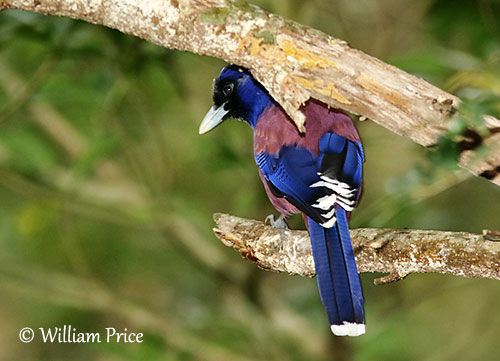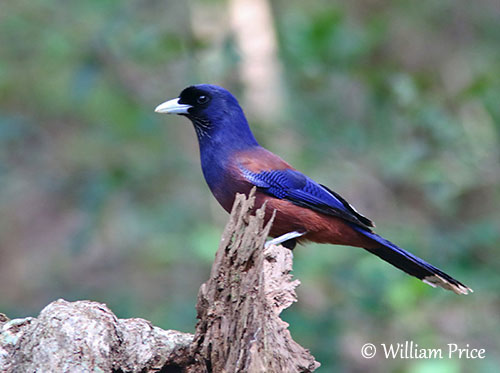
The Lidth’s Jay is monogamous. It nests in cavities where the cup-shaped nest is built. Following nest-failure, they abandon the nest, but a new one may be built again. A small territory of 150/300 m² is usually maintained.
This species is resident. It is a good flier and flies with frequent wingbeats.
REPRODUCTION OF THIS SPECIES:
From some observations, eggs are recorded in February and March.
The Lidth’s Jay is solitary nester. It nests in a variety of cavities such as tree holes, including at base of trees, in branches and epiphytic ferns. It may also use hollows in slopes and cliffs, or even in human habitations.
The cup-shaped nest is made with fine twigs and vines for the base, whereas the inner cup is lined with fine dry grass, rootlets and other soft plant materials.
The female lays 3-5 pale blue eggs and incubates during 17-20 days. The young usually fledge 25 days after hatching, but they often leave the nest prematurely due to predation pressure. They are fed by regurgitation by both parents. Egg shells and dead chicks are removed from the nest by the adults.
The young birds tend to form a flock around June.
PROTECTION / THREATS / STATUS:
The Lidth’s Jay has very restricted range. It is threatened by predators during the nesting period such as crows and mammals, and also the Indian mongoose (Herpestes auropunctatus) and snakes. The complete eradication of this mongoose is in progress.
The species is legally protected in Japan. The global population is estimated to number 5,800 individuals, but further research is required. This population is suspected to be fairly stable in spite of a moderate decline overall.
The Lidth’s Jay is currently listed as Vulnerable.
Fr: Geai de Lidth
Ang: Lidth’s Jay
All: Prachthäher
Esp: Arrendajo de Lidth
Ita: Ghiandaia di Lidth
Nd: Lidths Gaai
Sd: amamiskrika
Photographer:
William Price
PBase-tereksandpiper & Flickr William Price
Text by Nicole Bouglouan
Sources:
HANDBOOK OF THE BIRDS OF THE WORLD Vol 14 by Josep del Hoyo-Andrew Elliot-David Christie - Lynx Edicions – ISBN: 9788496553507
CORBEAUX ET GEAIS: Guide des Corbeaux, Geais et Pies du Monde – Steve Madge, Hilary Burn – Editeur : Vigot (18/04/1996) – ISBN 10: 2711412687 – ISBN 13 : 978-2711412686
Birds of East Asia: China, Taiwan, Korea, Japan, and Russia De Mark Brazil – Editeur: A&C Black, 2009 – ISBN: 0691139261, 9780691139265 - 528 pages
Avibase (Denis Lepage)
Birdlife International
Wikipedia, the free encyclopaedia
Bird Research News - Vol.7 No.4
Lidth’s Jay
Garrulus lidthi
Passeriformes Order – Corvidae Family
INTRODUCTION:
The Lidth’s Jay is resident and endemic to Amami Islands in S Japan. It frequents laurel natural forest and mixed secondary growths, and usually roosts in the canopy of tall trees. Like other Corvidae, it is omnivorous and feeds on various invertebrates, small vertebrates and vegetal matter.
This monogamous species nests in tree cavities and other hollows. The young are fed by regurgitation by the adults.
The Lidth’s Jay is threatened by predators during the nesting period such as crows, mammals and snakes. This species is legally protected in Japan and two islands are National Wildlife Protection Area. But the species is currently listed as Vulnerable.
The name of this jay pays tribute to the Dutch zoologist Theodoor Gerard van Lidth de Jeude.
DESCRIPTION OF THE BIRD:
Biometrics:
Length: 38 cm
Weight: M: 165-210 g – F: 170-195 g
The Lidth’s Jay has deep blue and reddish-chestnut plumage. This bird shows a beautiful combination of deep blue hood, wings and tail, and reddish-chestnut mantle, back, rump, breast, belly and vent.
The wings are largely dark blue, but the coverts are finely barred black. The flight-feathers are black with blue outer fringes and small white spots at tips. The tail shows broad white tips, especially on the underside. It is slightly graduated at tip.

On the head, the face is black on forehead, lores and chin, with fine white streaking on chin and throat.
Forehead and loral feathering are slightly stiffened, whereas the crown feathers are very slightly elongated and can be inconspicuously erected.
The stout bill is pale yellowish with greener base. The eyes are dark violet-blue. Legs and feet are dark grey.
Male and female are similar.
The juvenile is much duller, with mostly brownish or dark greyish instead of blue, whereas the chestnut areas are dull brown. The white tips of tertials and tail are absent.
RANGE:
The Lidth’s Jay is found in Amami Ō-shima in N Ryukyu Islands in S Japan.
HABITAT:
The Lidth’s Jay frequents mature forests and primarily laurel natural forest, and also secondary mixed forest with pines (Pinus Ryuchuensis). It can be seen in farmland, plantations and small patches of trees near villages, about 100-200 metres from the forest. This species is widespread in lowlands and mountains.
CALLS AND SONGS: SOUNDS BY XENO-CANTO
The Lidth’s Jay produces a variety of calls such as harsh, grating “jarr-jarr” or “kraah” in alarm. Contact calls between adults and young or while going in and out of the roost are described as “kyrurr-kyrwhit-kyrwhir-kurrwhir”. It may call for up to 3 minutes.
During the displays, the birds give screech calls. The old nestlings may produce a sharp rattle that can have an anti-predator effect too.
BEHAVIOUR IN THE WILD:
The Lidth’s Jay is omnivorous and feeds on insects and spiders, small vertebrates such as reptiles and birds, but also fruits, berries and seeds of native plants and crops. It also feeds on acorns and chestnuts, and usually stores them for later use. It is able to carry up to six acorns in the throat pouch and the bill.
The Lidth’s Jay forages by moving among branches and foliage, inspecting carefully bark crevices, holes and leaves.
It may use its strong bill as a climbing aid, like parrots. It can be seen perched on exposed rocks, treetops or large bushes.
